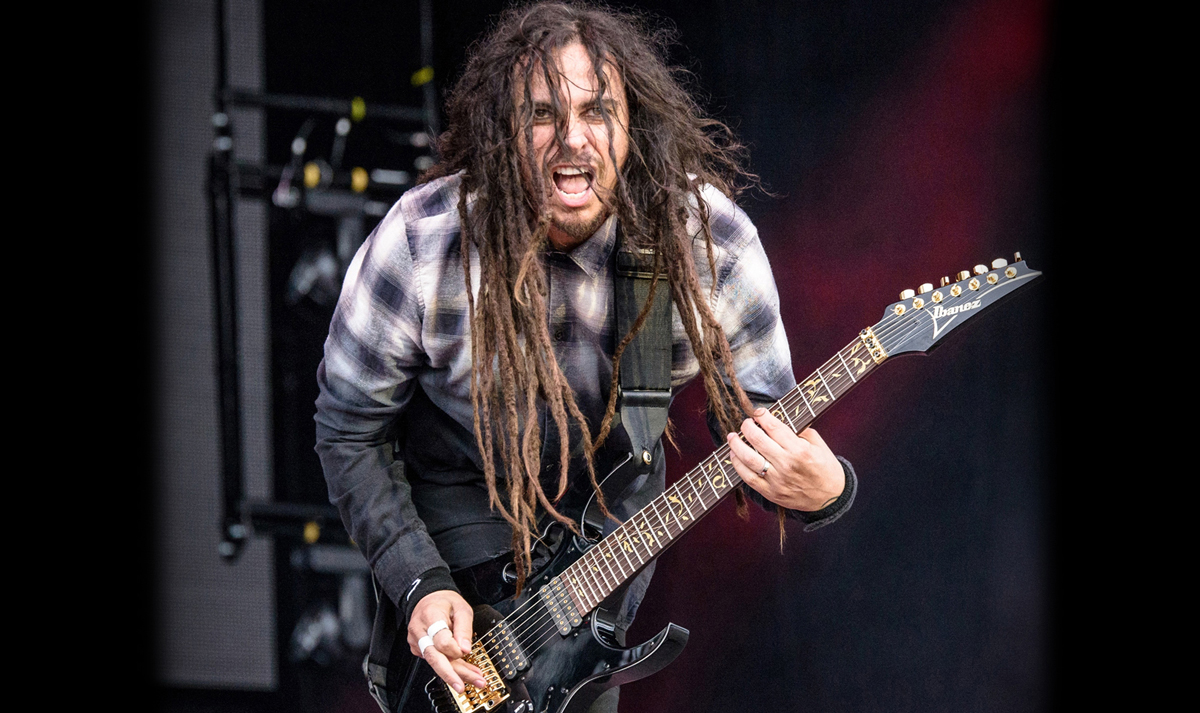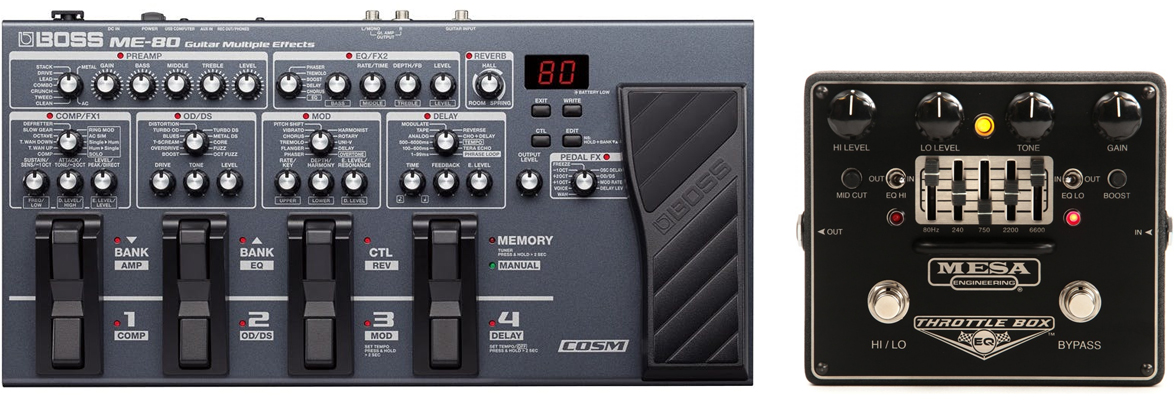Sound Like Korn Without Busting The Bank!
After years of heavy demand from our Sound Like fans, Rabea and Matt finally felt a "need to" recreate the groundbreaking guitar tones of Korn - on a budget of £1500 each!
If you want to learn all about the gear that Korn guitarists James "Munky" Shaffer and Brian "Head" Welch have used throughout their careers; we breakdown their choices in guitars, amps and pedals in utmost detail. Did Rabea and Matt's more affordable alternatives make the grade? Let's find out!
Korn are regarded as the godfathers of the nu-metal genre. Bursting onto the scene in 1994 with their explosive self-titled debut album, Korn played a part in ending the grunge era that had filled airwaves so much in the early ’90s. As one of many successful bands that successfully emerged from that decade, Korn remains as popular as ever while many of its contemporaries have faded into obscurity. Their latest album ‘The Nothing’ shows that they’ve still got it!
Blending distorted drop-tuned guitars with aggressive grooves, percussive basslines and frenetic vocals; Korn established a unique sound that has evolved over their 12-album back catalogue. With elements of rap, funk, alternative and industrial metal also thrown into the mix; there aren’t many bands out there that are as distinctive or experimental as Korn.
With such a large discography, Rabea and Matt had to work hard to cover all of the bases in this episode of Sound Like. Focusing on their biggest hits rather than specific albums, the fellas tapped into many of Korn’s signature sounds and recreated them with great conviction.
Guitars

Munky and Head were among some of the very first musicians to use 7-string guitars exclusively. With Ibanez developing the bodacious Universe guitar for Steve Vai in 1990, which was arguably the first mass-produced 7-string available on the market; this instrument inspired a new generation of metallers that took advantage of its additional low B string, with Korn and Fear Factory its earliest proponents. But Munky and Head took things to the extreme; tuning the lowest string down by a further tone for drop A tuning. Heavy indeed!
Ibanez APEX200

The Korn axemen have been associated with Ibanez for a very long time. Munky has used their instruments for over 25 years, and his signature APEX model has been in the Ibanez catalogue since 2007. Taking heavy inspiration from Vai’s Universe guitar with its stealthy RG body shape and pickguard design, the Ibanez APEX has nevertheless undergone many transformations over the years. Powerful Dimarzio pickups and reliable locking bridge systems have always been mainstays though.
ESP LTD SH-7

Head used Ibanez 7-string guitars during his first stint with Korn (1993-2005) and upon his return in 2013. He made a shock switch to ESP in 2016 though, and together they unveiled a signature model at the following year’s NAMM Show. Head’s ESP LTD SH-7 guitar is distinctive for its Evertune bridge and active Fishman Fluence pickups – making it a true modern metal machine!
For our episode of Sound Like, Rabea and Matt decided to forgo using Munky and Head’s signature instruments. This was mostly due to their expense; meaning that the guys would have exceeded their budgets of £1500 each. The more affordable electric guitars that they chose were worthy alternatives though.
Ibanez Iron Label RGDIR7M-LBM

Rabea chose the stunning Ibanez Iron Label RGDIR7M-LBM 7-string guitar; finished in a vibrant Laser Blue Matte colour. Aesthetics aside, this particular instrument closely resembles Munky’s signature model as it boasts DiMarzio pickups. Fitted with Fusion Edge humbuckers, these pickups are capable of handling high doses of gain and provide plenty of saturation for tracks like “Got The Life” and “Blind”. They’re not one-trick ponies though, as with clean settings they sound very articulate and clear; as you could hear in the “Falling Away From Me” excerpt. This guitar does lack a locking bridge, but its rock-solid Gibraltar Standard II-7 bridge and Ibanez Locking tuners ensure excellent tuning stability.
Jackson JS32-7 Dinky

Matt decided to go for something completely different, and picked a Jackson JS32-7 Dinky. Extremely affordable, this particular guitar features the essential dual-humbucker configuration needed to cover all of Korn’s tones. Fitted with Jackson-branded high-output pickups, these are voiced for a deep and rich sound that ensures that the 7th string sounds full and defined with distorted or clean amp settings.
Amplifiers

Munky and Head have used a bunch of high-gain guitar amps over the years. Experimenting with models from the likes of Diezel, Bogner and Marshall in the studio, their Mesa/Boogie Triple Rectifiers have always been live performance mainstays. Serving as their distorted amps, these notoriously lairy valve head staples offer incredible headroom with 150W of unbridled power; allowing the full range of Munky and Head’s 7-string guitars to be heard. These Triple Rectifiers are matched with several Mesa/Boogie 4×12 cabinets that ensure excellent projection onstage.
For their clean tones, Munky and Head rely on Kemper Profiling amps. Kemper amps have become extremely popular with professional touring musicians, due to their compact form-factors, reliable valve-less design and of course – their extremely convincing sounds. If Munky and Head’s Triple Rectifiers go down during a set, the Kempers can be relied on as backups too.
Mesa/Boogies were out of the question for this edition of Sound Like, as they’re very expensive! Rabea and Matt therefore had to find some suitable substitutes that could deliver the high levels of gain that Mesas can achieve, while having the versatility to provide crystal-clear cleans too.
Boss Katana Artist

As the Ibanez that Rabea chose took up almost half of his budget, he didn’t have much left to play with when it came to amps and pedals. He ultimately settled on the Boss Katana Artist combo; a flexible modelling amp that offers a multitude of sounds. To recreate Korn’s thick and almost muddy distorted tones, Rabea cranked the bass and turned the presence all the way down.
Blackstar Studio 10

Matt fortunately had quite a lot of money remaining from his £1500 budget. This meant that he had several valve amp options at his disposal; ultimately choosing the Blackstar Studio 10 combo. This amplifier features EL34 tubes, which are synonymous with the “British sound”. Matt therefore ran a Mesa/Boogie Throttle Box distortion pedal into the front end to capture that mid-scooped, American high-gain character; thus emulating Munky and Head’s Triple Rectifiers.
Pedals

Tonnes of weird and wonderful modulation, pitch-shifting and delay effects are heard in Korn’s music; showing their alternative roots. In the late ’90s, both Munky and Head had outrageously complex pedalboards that featured multiple effects. But today, they’ve scaled things back to just a few essentials and use a mix of Boss, Digitech, Electro Harmonix and MXR stompboxes. Munky and Head have always used effects in an additive way to embellish certain parts, while their amps provide their core sounds.
The discontinued Digitech XP-100 Whammy/Wah is perhaps the most interesting pedal that both players rely on. Used in a bunch of the their tracks, its octave-down effect can be heard most prominently in “Here To Stay”; arguably Korn’s heaviest song.
Modulation is another key ingredient of the Korn sound, with Munky and Head using chorus, flanger, phaser and univibe pedals to attain creepy and unsettling sounds. They usually achieve this by setting their rate/time controls to be fast, thus creating a sinister-sounding warble. The intro of “Falling Away From Me” is a prime example, featuring a chorus-laden clean passage with an eerie reverb.
BOSS ME-80 & Mesa/Boogie Throttle Box

Rabea and Matt decided to use a Boss ME-80 multi-FX pedal to cover the various effects that Korn uses. This was far more cost-effective than buying single pedals, and meant that they could dial-in effect patches to be recalled for certain songs and sections. Also featuring a built-in expression pedal, this allows you to emulate the whammy and wah effects that Munky and Head frequently use.
As mentioned earlier, Matt used a Mesa/Boogie Throttle Box distortion pedal and ran it into his Blackstar Studio 10. Able to reach the insane gain levels possible with a Triple Rectifier, the Throttle Box is also very tweakable and amp-like with its 5-band EQ section.
Want to Learn More?
If you’re interested in finding out how to achieve the tones of your favourite artists, check out more of our Sound Like articles by clicking here!



Responses & Questions